
The Metropolitan State Hospital was an American public hospital for the mentally ill, on grounds that extended across parts of Waltham, Lexington, and Belmont, Massachusetts. Founded in 1927, it was at one time the largest and most modern facility of its type in Massachusetts. It was closed in January 1992 as a result of the state's cost-cutting policy of closing its mental hospitals and moving patients into private and community-based settings. The main complex of buildings has subsequently been redeveloped into apartments. The hospital campus was listed on the National Register of Historic Places 1994. The property also housed the Gaebler Children's Center for mentally ill youth.

The Boston Athenaeum is one of the oldest independent libraries in the United States. It is also one of a number of membership libraries, for which patrons pay a yearly subscription fee to use Athenaeum services. The institution was founded in 1807 by the Anthology Club of Boston, Massachusetts. It is located at 10½ Beacon Street on Beacon Hill.

The Converse Memorial Library – also known as Converse Memorial Building – is a historically significant building designed by noted American architect Henry Hobson Richardson. From 1885 to 1996, it housed the Malden Public Library, which now occupies a modern building adjacent to it. The former library is located at 36 Salem Street, Malden, Massachusetts.
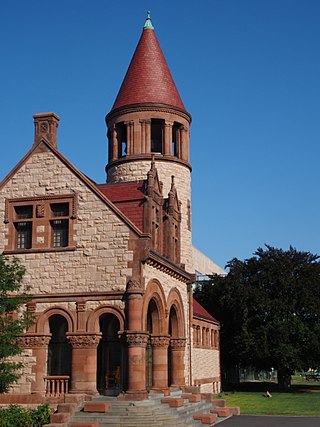
The Cambridge Public Library (CPL) in Cambridge, Massachusetts consists of a unified city-wide system maintaining: a main branch, of notable aesthetic architectural value, plus a further six localized branches sited throughout the city. Having evolved from the Cambridge Athenaeum, the main library branch was built at its present site in 1888. The main library most recently underwent renovation, and a modern building addition significantly expanded the overall branch in 2009. Thus, it greatly increased the branch's area, more than tripling its square footage.

Taunton Public Library is the public library of Taunton, Massachusetts. It is located at 12 Pleasant Street, in an architecturally distinguished Beaux Arts building built in 1903 with funding support from Andrew Carnegie, to which a modern addition was made in 1979. The building is listed on the National Register of Historic Places as a particularly fine local example of Beaux Arts architecture.

Christ Church is a historic Episcopal church at 750 Main Street in Waltham, Massachusetts. The church is a parish of the Episcopal Diocese of Massachusetts, and was named to the National Register of Historic Places in 1989.

The Trinity Church, formerly the First Congregational Church, is a historic church in Waltham, Massachusetts. The present church building, an architecturally distinctive blend of Romanesque and Georgian Revival styling, was built in 1870 for a congregation established in 1820. It was listed on the National Register of Historic Places in 1989.

Case's Corner Historic District is a residential, civic, and rural historic district in the geographic center of Weston, Massachusetts. The district is centered on the four-way intersection of School, Wellesley, Newton and Ash Streets in Weston, Massachusetts, and runs mainly along Wellesley Street, which runs north-south through the district between the centers of Weston and Wellesley. The district encompasses a pastoral landscape managed by Marian Case, a horticulturalist and landscape preservationist. One of its central features is the Case Estates, a 60-acre (24 ha) property bequested by Case to Harvard University that once served as a nursery for Boston's Arnold Arboretum. The district was listed on the National Register of Historic Places in 2002.
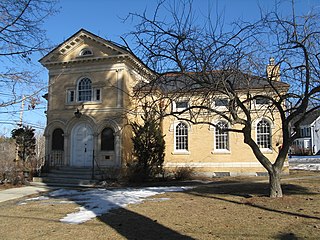
The Houghton Memorial Building is a historic civic building at 4 Rogers Street in Littleton, Massachusetts. Built in 1895 to a design by Perkins & Betton, this Colonial Revival style housed the local public library for many years. It presently houses the Littleton Historical Society. The building was listed on the National Register of Historic Places on March 18, 1991.
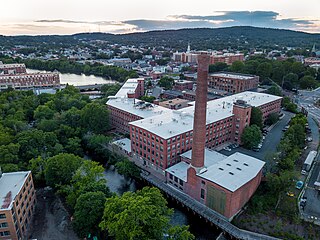
Charles River Museum of Industry & Innovation is a museum of the American Industrial Revolution located on the Charles River Bike Path, near the intersection of the Charles River and Moody Street in Waltham, Massachusetts. It houses and displays machinery and artifacts of the industrial revolution from the nineteenth and twentieth centuries. The building was originally built as part of the Boston Manufacturing Company, Francis Cabot Lowell's seminal, fully integrated textile mill. The museum, which was incorporated in 1980 and opened to the public in 1988, takes up only a small portion of the previous mill building complex.
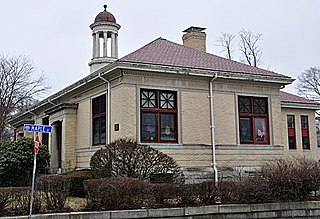
The Stoneham Public Library is the public library of Stoneham, Massachusetts. It is located at Main and Maple Streets.

The Company F State Armory, also known as the Waltham State Armory, is a historic armory building at Curtis and Sharon Streets in Waltham, Massachusetts. Built in 1908, it is locally notable for its Georgian Revival architecture, and as the city's only armory building. It was among the last of the state's armories to be built to individualized architectural design. The building was listed on the National Register of Historic Places in 1989. The building is vacant.
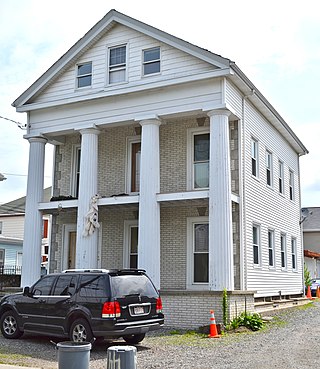
The Francis Buttrick House is a historic house at 44 Harvard Street in Waltham, Massachusetts. Built before 1852, it is one of a small number of temple-front Greek Revival houses in the city. It was listed on the National Register of Historic Places in 1989.
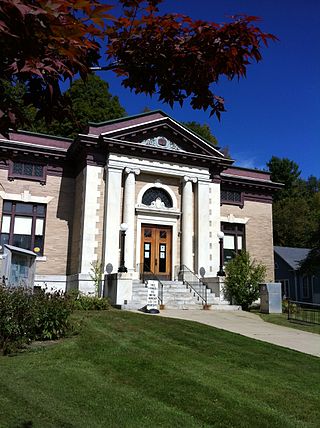
Ramsdell Public Library is one of two public library buildings of Great Barrington, Massachusetts. It is located at 1087 Main Street in the Housatonic village, in a two-story Beaux Arts building erected c. 1908. The building was a gift to the town by T. Ellis Ramsdell, fulfilling a bequest by his father Theodore, owner of the Monument Mills. It was designed by Boston architects McLean & Wright, with a sympathetic rear addition designed by the Pittsfield firm of Harding & Seaver. It was listed on the National Register of Historic Places in 2014.
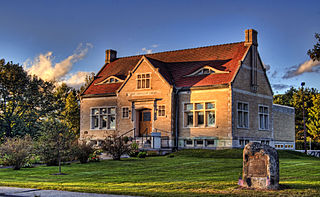
The Abbie Greenleaf Library is the public library in Franconia, New Hampshire. It is located at 439 Main St. in the center of the main village, in a Jacobethan building designed by William H. McLean and built in 1912. The building was a gift to the town from Charles Greenleaf and named in honor of his wife. Greenleaf was owner of the Profile House, a major resort hotel in Franconia. The library had an addition designed by Carter & Woodruff of Nashua built in 1971. The building was listed on the National Register of Historic Places in 2003.
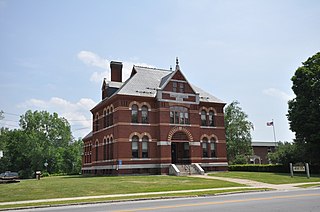
The Conant Public Library is the public library of Winchester, New Hampshire. It is located at 111 Main Street, in a fine Victorian Romanesque Revival building erected in 1891, funded by a bequest from Winchester resident Ezra Conant. The building's design, by Springfield, Massachusetts architect, J. M. Currier, is based on his design of the 1886 library building in Brattleboro, Vermont, and is one of the most architecturally distinguished buildings in Cheshire County. It was listed on the National Register of Historic Places in 1987.

Brewster Memorial Hall is the town hall of Wolfeboro, New Hampshire. It is located at the junction of South Main Street and Union Street in the town center. Its construction in 1880-90 was the result of a bequest from Wolfeboro native John W. Brewster, with terms stipulating that the building should resemble Sargent Hall in Merrimac, Massachusetts. It was listed on the National Register of Historic Places in 1983.

Gallison Memorial Library is the public library of Harrington, Maine. It is located at 1292 Main Street in Harrington's rural village center, in a small architecturally distinguished Colonial Revival brick building that is listed on the National Register of Historic Places. The building was a gift to the town from Alice (Strout) Gallison in memory of her husband Forest, and was built in 1922–23, with a major expansion in 2004.

The Gale Memorial Library is the public library of Laconia, New Hampshire. It is located at 695 Main Street in a Richardsonian Romanesque building, whose 1901–03 construction was funded by a bequest from Napoleon Bonaparte Gale, a local banker. The building was designed by Boston architect Charles Brigham, and is listed on the National Register of Historic Places.

Charles Greely Loring III was an American architect based in Boston.























